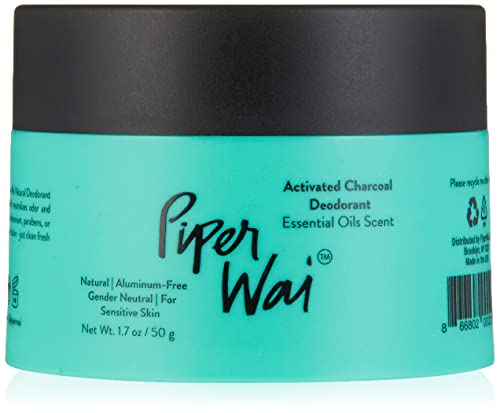
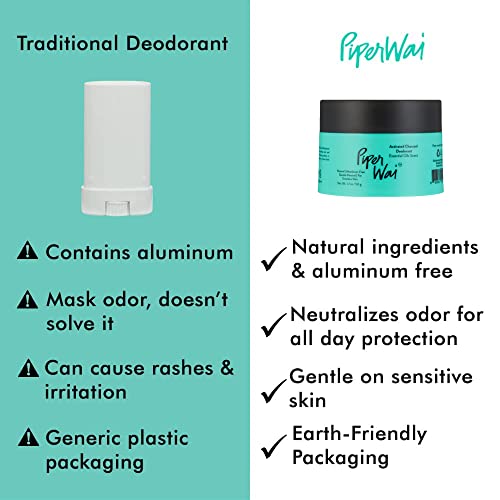
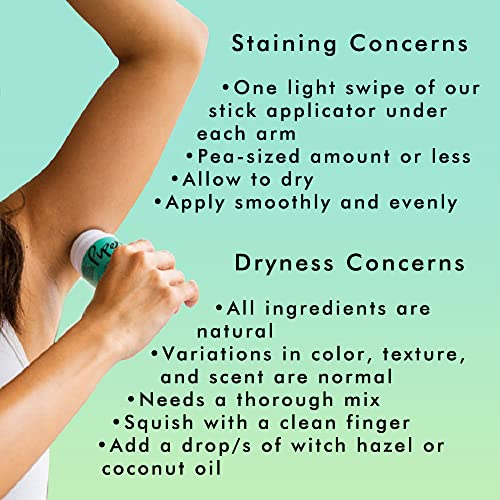
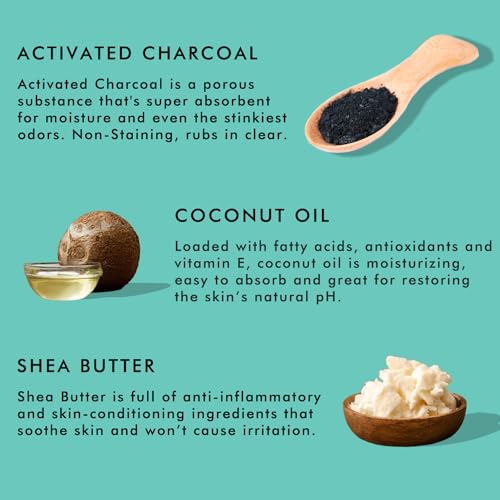
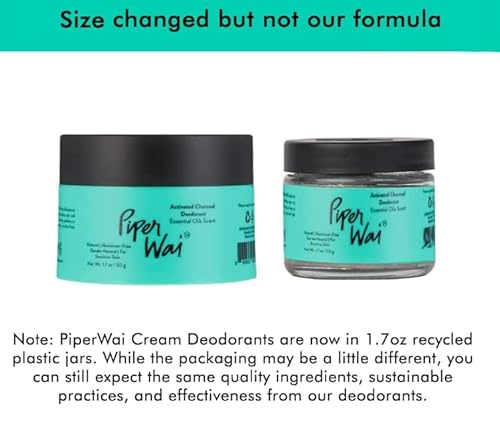



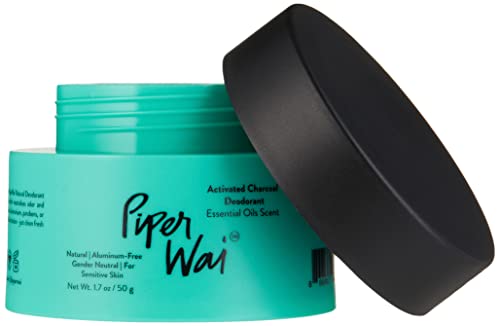
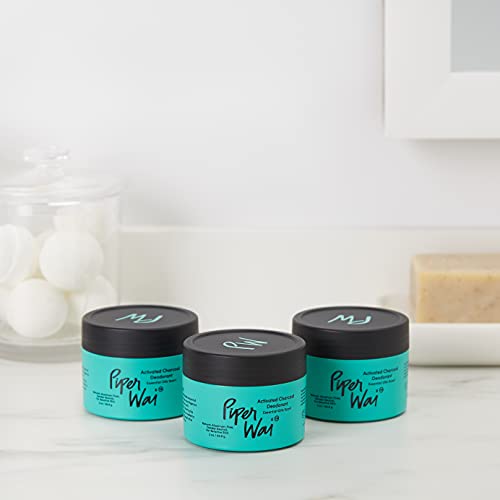
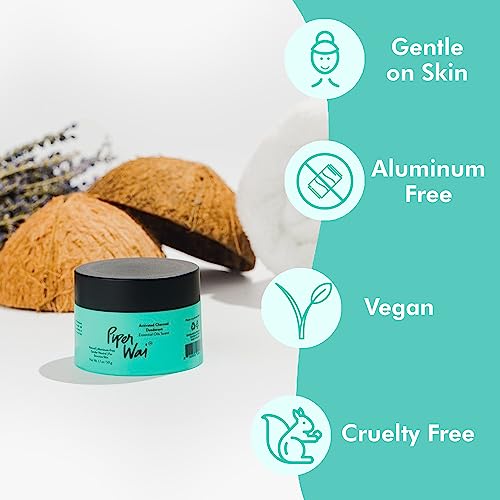
PiperWai Natural Deodorant - Odor Protection, Vegan, Aluminum-Free, Activated Charcoal - 50g


Cymbopogon (Lemon Grass) Oil
High RiskCymbopogon (lemongrass) oil is an essential oil derived from the leaves and stalks of lemongrass plants. It is primarily used for its aromatic properties in cosmetics and personal care products, serving as a fragrance component and potential antimicrobial agent.
Sustai Insights
Lemongrass oil offers functional benefits as a natural fragrance and antimicrobial agent. However, it has a high allergenic potential, which may cause skin sensitization or irritation. Environmental concerns include possible irritation to aquatic life if released into water systems. Regulatory bodies advise caution due to its enhanced skin absorption properties. Overall, the ingredient presents a high-risk profile, necessitating careful consideration in formulation. Safer alternatives may include synthetic fragrances or other essential oils with lower allergenic profiles.
Mentha Piperita (Peppermint) Oil
High RiskMentha piperita (peppermint) oil is a volatile oil extracted from the leaves of the peppermint plant, known for its strong aroma and flavor. It is commonly used in cosmetics and personal care products for its cooling properties and fragrance enhancement.
Sustai Insights
Peppermint oil offers functional benefits such as antimicrobial properties and a soothing sensation on the skin. However, it is associated with a high potential for allergies and skin irritation. Regulatory bodies impose certain restrictions on its use due to these concerns. The overall risk level is assessed as high, warranting caution in usage, especially for sensitive populations. Alternatives like spearmint oil may provide similar benefits with potentially lower irritation risks.
Rosmarinus Officinalis (Rosemary) Leaf Oil
Medium RiskRosmarinus officinalis (rosemary) leaf oil is extracted from the leaves of the rosemary plant. It is commonly used in cosmetic and personal care products for its aromatic properties and potential preservative benefits due to its antioxidant content.
Sustai Insights
Rosemary leaf oil offers functional benefits such as antimicrobial and antioxidant properties, which can enhance product stability. It is derived from a renewable source and is biodegradable. However, it presents moderate risks of allergic reactions and skin irritation, particularly with enhanced skin absorption. Regulatory bodies have noted restrictions on its usage in specific concentrations. The overall risk level is assessed as medium. Users are advised to follow safe usage practices and may consider alternatives like tocopherols or other natural preservatives.
Eucalyptus Globulus (Eucalyptus) Leaf Oil
Medium RiskEucalyptus globulus leaf oil is a volatile oil derived from the leaves of the eucalyptus tree, primarily used for its aromatic properties and as a potential antimicrobial agent in various products.
Sustai Insights
Eucalyptus globulus leaf oil offers functional benefits like fragrance and potential antimicrobial properties, supporting product efficacy. However, it presents high allergenic potential and moderate irritation concerns, which may pose health risks. Environmental risks include possible pollution and bioaccumulation. Regulatory restrictions are in place regarding its use in certain products. Overall, the risk level is medium, necessitating caution in usage and consideration of alternatives like tea tree oil or peppermint oil.
Citrus Reticulata Peel Oil
Medium RiskCitrus reticulata peel oil is an essential oil derived from the peel of the mandarin orange. It is commonly used in cosmetic and personal care products for its fragrance and potential skin-conditioning properties. The oil is obtained through cold pressing, preserving its natural components.
Sustai Insights
Citrus reticulata peel oil offers functional benefits such as natural fragrance and potential antimicrobial effects. However, it carries a high allergenic potential, with risks of skin irritation and other allergic reactions. Regulatory bodies have noted moderate usage restrictions due to persistence and bioaccumulation concerns. Overall, the ingredient presents a medium risk level, necessitating careful usage practices, particularly for sensitive populations. Safer alternatives may include synthetic or other plant-derived fragrances.
Melaleuca Alternifolia (Tea Tree) Leaf Oil
Medium RiskMelaleuca alternifolia (tea tree) leaf oil is derived from the leaves of the Melaleuca alternifolia tree. It is commonly used in personal care products for its antiseptic and antimicrobial properties, making it a popular ingredient for skincare formulations.
Sustai Insights
Tea tree leaf oil offers functional benefits, including antimicrobial properties that can help with skin conditions. However, it has a high allergenic potential and may cause skin irritation or allergic reactions in sensitive individuals. Additionally, while it poses low to moderate risks concerning endocrine disruption and reproductive toxicity, it is restricted in certain formulations. Overall, the ingredient is assessed as medium risk, necessitating careful usage and consideration of alternatives for sensitive populations.
Activated Charcoal
Low RiskActivated charcoal is a dried, carbonaceous material known for its porous structure, primarily used in personal care and medical products for its adsorptive properties. It effectively binds to impurities and toxins, aiding in detoxification and cleansing processes.
Sustai Insights
Activated charcoal offers functional benefits such as effective adsorption of toxins and impurities, contributing to its use in various products, while being biodegradable and potentially sustainably sourced. Health risks are minimal, with low concerns regarding carcinogenicity, allergies, or reproductive toxicity. Environmental risks are also low, as it does not significantly contribute to pollution or bioaccumulation. Regulatory bodies have not issued warnings against its use, indicating low risk overall. Safe usage practices include ensuring proper formulation concentrations. While alternatives exist, activated charcoal remains a low-risk choice for consumers.
Lavandula Angustifolia (Lavender) Oil
Low RiskLavandula angustifolia (lavender) oil is a volatile oil derived from the flowers of the lavender plant. It is commonly used in cosmetic and personal care products for its fragrance and potential calming properties.
Sustai Insights
Lavender oil offers functional benefits such as providing fragrance and potential relaxation effects. It is biodegradable and often sustainably sourced. Health risks are minimal, with low concerns for carcinogenicity, allergies, or reproductive toxicity; however, there is a low to moderate concern regarding endocrine disruption. Environmental risks are low, with no significant pollutant or bioaccumulation potential noted. Regulatory status is favorable, with no current restrictions. Safe usage practices include avoiding excessive concentrations, especially in sensitive applications. Overall, the risk level associated with lavender oil is assessed as low.
Magnesium Hydroxide
Low RiskMagnesium hydroxide is an inorganic base commonly used in various applications, including as an antacid and laxative. It serves to neutralize stomach acid and relieve constipation. It is also utilized in wastewater treatment and as a flame retardant in plastics.
Sustai Insights
Magnesium hydroxide provides effective relief from indigestion and constipation, contributing to digestive health. It is recognized for its low environmental impact and is generally regarded as safe with minimal health risks, including low concerns for carcinogenicity, allergies, and reproductive toxicity. Regulatory bodies have few restrictions on its use, classifying it as low risk overall. However, precautions should be taken to avoid excessive consumption, and alternatives like calcium carbonate may be considered for similar functions. Overall, magnesium hydroxide is assessed as low risk.
Sodium Bicarbonate
Low RiskSodium bicarbonate, commonly known as baking soda, is an inorganic compound with the formula NaHCO₃. It functions primarily as a leavening agent in baking, helping to produce carbon dioxide gas when it reacts with acids, thereby causing dough to rise. It also serves as a mild alkaline agent in various personal care products.
Sustai Insights
Sodium bicarbonate is valued for its effectiveness as a leavening agent and its role in neutralizing acidity, contributing to product stability. It is considered environmentally friendly and biodegradable. Health risks are minimal, with low concerns regarding carcinogenicity, allergies, and reproductive toxicity. It is not classified as a pollutant and poses no significant environmental hazards. Regulatory assessments indicate it is safe for use in food and cosmetic products. Overall, sodium bicarbonate carries a low risk, making it a practical choice in many applications.
Euphorbia Cerifera (Candelilla) Wax
Low RiskCandelilla wax is extracted from Euphorbia cerifera, a shrub native to northern Mexico and the southwestern United States. It is primarily used as a thickening agent, emollient, and film-forming agent in cosmetic and personal care products.
Sustai Insights
Candelilla wax serves effectively as a natural thickener and emollient, contributing to product texture and moisture retention. It is biodegradable and sourced sustainably, supporting eco-friendly formulations. Health risks are low, with minimal concerns about sensitization. Environmental hazards are also low, with no significant pollutant or bioaccumulation potential noted. Regulatory bodies impose few restrictions, indicating overall low risk. Safe usage practices should be followed, and alternatives like carnauba wax may be considered for those seeking different plant-based options.
Polymethylsilsesquioxane
Low RiskPolymethylsilsesquioxane is a polymer formed by the condensation of silanol groups. It is commonly used in cosmetic formulations due to its film-forming properties, contributing to texture and smoothness in products such as creams and lotions.
Sustai Insights
Polymethylsilsesquioxane offers functional benefits by enhancing product texture and providing a smooth application. It has a low risk of health concerns, including cancer, allergies, and reproductive toxicity, with minimal irritation potential. Environmentally, it poses low risks as a pollutant and is not bioaccumulative. Regulatory bodies have not placed significant restrictions on its use, indicating a low overall risk level. Safe usage practices should be observed, and while alternatives exist, they may not replicate its unique properties.
Tapioca Starch
Low RiskTapioca starch is a carbohydrate extracted from the cassava root, primarily used as a thickening agent in food products and as a binding agent in various formulations. It is known for its ability to provide a smooth texture and enhance the consistency of products.
Sustai Insights
Tapioca starch offers functional benefits such as serving as an effective thickener and stabilizer in food and cosmetic formulations. It is derived from a renewable source and is biodegradable, contributing to sustainability. Health risks are minimal, with low concerns regarding carcinogenicity, allergenic potential, and reproductive toxicity. Environmental risks are also low, with no significant pollutants or bioaccumulation identified. Regulatory bodies, including the FDA, have approved its use without significant restrictions. Overall, tapioca starch presents a low risk profile, making it a safe ingredient in various applications.
Theobroma Cacao (Cocoa) Seed Butter
Low RiskTheobroma cacao (cocoa) seed butter is extracted from the roasted seeds of the cocoa plant. It is commonly used in cosmetics and skincare products for its emollient properties, helping to moisturize and soften the skin. Cocoa butter is also known for its stability and resistance to rancidity.
Sustai Insights
Cocoa butter is recognized for its effective moisturizing properties and is sustainably sourced, contributing to its appeal in personal care products. It poses low health risks, with minimal concerns regarding carcinogenicity, allergies, or reproductive toxicity. Environmentally, it does not significantly contribute to pollution or bioaccumulation. Regulatory bodies impose few restrictions, affirming its safety. Overall, the risk associated with cocoa seed butter is low, making it a favorable ingredient in cosmetics. Alternatives include shea butter or plant oils for similar emollient benefits.
Glycine Soja (Soybean) Oil
Low RiskGlycine soja (soybean) oil is derived from the seeds of the soybean plant and is commonly used in cosmetic formulations for its emollient properties. It functions as a moisturizer and skin conditioning agent, enhancing the texture and feel of products.
Sustai Insights
Glycine soja (soybean) oil offers functional benefits such as effective skin moisturization and conditioning. It is generally recognized as low-risk for health concerns, with minimal allergenic potential and no significant environmental hazards reported. Regulatory bodies have not imposed restrictions on its use. Overall, this ingredient is assessed as low risk, making it a suitable option for various cosmetic applications.
Hamamelis Virginiana (Witch Hazel) Leaf Extract
Low RiskHamamelis virginiana (witch hazel) leaf extract is derived from the leaves of the witch hazel plant. It is commonly used in cosmetic formulations for its astringent properties, helping to tighten and tone the skin. This extract is often included in products designed for skin care, particularly for soothing minor skin irritations.
Sustai Insights
Hamamelis virginiana leaf extract offers functional benefits as an astringent, which can help reduce skin inflammation and improve skin appearance. It is generally regarded as safe with low risk of health concerns, including carcinogenicity and allergenic potential. Environmental impacts are minimal, and it is not bioaccumulative. Regulatory bodies impose few restrictions, reflecting its acceptance in cosmetic formulations. Safe usage practices should be followed, and alternatives like green tea extract may provide similar benefits with enhanced antioxidant properties. Overall, the risk level associated with this ingredient is low.
Thymus Vulgaris (Common Thyme) Oil
Low RiskThymus vulgaris (thyme) oil is a volatile oil extracted from the leaves and flowers of the thyme plant. It is commonly used in cosmetic and personal care products for its aromatic properties and potential antimicrobial effects.
Sustai Insights
Thyme oil offers functional benefits, including antimicrobial properties and use as a natural fragrance in products. It is sustainably sourced and biodegradable. Health risks are minimal, with low concerns regarding carcinogenicity, allergies, and reproductive toxicity. Environmental risks are also low, with no significant pollutants or bioaccumulation. Regulatory bodies do not impose major restrictions, indicating its safety profile. Overall, the risk level is low, making thyme oil a favorable ingredient choice.
Tocopherol
Low RiskTocopherols are a class of naturally occurring compounds, primarily known for their role as antioxidants. They are commonly used in cosmetic and skincare products to help stabilize formulations and protect ingredients from oxidative damage.
Sustai Insights
Tocopherols provide functional benefits such as antioxidant protection and skin conditioning. They are generally recognized as safe, with low concerns regarding carcinogenicity, allergies, and reproductive toxicity. However, enhanced skin absorption and potential endocrine disruption are noted. Regulatory bodies have not imposed significant restrictions on tocopherols, categorizing the overall risk as low. Safe usage practices should be observed, and while alternatives exist, tocopherols remain a viable option in formulations.
Cocos Nucifera (Coconut) Oil
Low RiskCocos Nucifera (Coconut) Oil is derived from the kernels of the coconut palm. It is primarily used in cosmetic formulations for its emollient and moisturizing properties, making it suitable for skin and hair care products.
Sustai Insights
Coconut oil serves as an effective moisturizer and emollient, promoting skin hydration and softness. It is sustainably sourced and biodegradable. Health risks are minimal, with low concerns regarding carcinogenicity, allergens, and reproductive toxicity. Environmental impact is also low, as it does not contribute significantly to pollution or bioaccumulation. Regulatory bodies have not issued restrictions on its use. Overall, coconut oil presents a low risk for health and environmental concerns, making it a safe ingredient in cosmetic products.
Butyrospermum Parkii (Shea) Butter
Low RiskButyrospermum parkii (shea) butter is a vegetable fat derived from the nuts of the shea tree. It is commonly used in cosmetic formulations for its emollient properties, providing moisture and improving skin texture. Additionally, shea butter is known for its ability to enhance the stability of products and deliver a creamy texture.
Sustai Insights
Shea butter offers functional benefits as an effective moisturizer, enhancing skin barrier function and texture. It is sustainably sourced and biodegradable, contributing to eco-friendliness. Health-wise, it is associated with low risks for carcinogenicity, allergies, and reproductive toxicity. Environmental impacts are minimal, with no significant pollutant potential identified. Regulatory assessments indicate no current restrictions. Overall, the ingredient presents a low risk, making it a favorable choice in cosmetic formulations.
Helianthus Annuus (Sunflower) Seed Oil
Low RiskHelianthus annuus (sunflower) seed oil is derived from the seeds of the sunflower plant. It serves primarily as an emollient and moisturizer in cosmetic formulations, helping to maintain skin hydration and improve texture.
Sustai Insights
Sunflower seed oil is effective as an emollient, providing moisture and improving skin texture while being biodegradable and sustainably sourced. It poses low health risks, including negligible concerns for carcinogenicity, allergies, or reproductive toxicity. Environmentally, it does not significantly contribute to pollution or bioaccumulation. Regulatory bodies currently do not list any advisories for this ingredient. Overall, it is assessed as low risk, with safe usage practices recommended. Alternatives include oils like jojoba or almond oil for those seeking different properties.
Rosmarinus Officinalis (Rosemary) Leaf Oil
Medium RiskRosmarinus officinalis (rosemary) leaf oil is extracted from the leaves of the rosemary plant. It is commonly used in cosmetic and personal care products for its aromatic properties and potential preservative benefits due to its antioxidant content.
Sustai Insights
Rosemary leaf oil offers functional benefits such as antimicrobial and antioxidant properties, which can enhance product stability. It is derived from a renewable source and is biodegradable. However, it presents moderate risks of allergic reactions and skin irritation, particularly with enhanced skin absorption. Regulatory bodies have noted restrictions on its usage in specific concentrations. The overall risk level is assessed as medium. Users are advised to follow safe usage practices and may consider alternatives like tocopherols or other natural preservatives.
Eucalyptus Globulus (Eucalyptus) Leaf Oil
Medium RiskEucalyptus globulus leaf oil is a volatile oil derived from the leaves of the eucalyptus tree, primarily used for its aromatic properties and as a potential antimicrobial agent in various products.
Sustai Insights
Eucalyptus globulus leaf oil offers functional benefits like fragrance and potential antimicrobial properties, supporting product efficacy. However, it presents high allergenic potential and moderate irritation concerns, which may pose health risks. Environmental risks include possible pollution and bioaccumulation. Regulatory restrictions are in place regarding its use in certain products. Overall, the risk level is medium, necessitating caution in usage and consideration of alternatives like tea tree oil or peppermint oil.
Activated Charcoal
Low RiskActivated charcoal is a dried, carbonaceous material known for its porous structure, primarily used in personal care and medical products for its adsorptive properties. It effectively binds to impurities and toxins, aiding in detoxification and cleansing processes.
Sustai Insights
Activated charcoal offers functional benefits such as effective adsorption of toxins and impurities, contributing to its use in various products, while being biodegradable and potentially sustainably sourced. Health risks are minimal, with low concerns regarding carcinogenicity, allergies, or reproductive toxicity. Environmental risks are also low, as it does not significantly contribute to pollution or bioaccumulation. Regulatory bodies have not issued warnings against its use, indicating low risk overall. Safe usage practices include ensuring proper formulation concentrations. While alternatives exist, activated charcoal remains a low-risk choice for consumers.
Lavandula Angustifolia (Lavender) Oil
Low RiskLavandula angustifolia (lavender) oil is a volatile oil derived from the flowers of the lavender plant. It is commonly used in cosmetic and personal care products for its fragrance and potential calming properties.
Sustai Insights
Lavender oil offers functional benefits such as providing fragrance and potential relaxation effects. It is biodegradable and often sustainably sourced. Health risks are minimal, with low concerns for carcinogenicity, allergies, or reproductive toxicity; however, there is a low to moderate concern regarding endocrine disruption. Environmental risks are low, with no significant pollutant or bioaccumulation potential noted. Regulatory status is favorable, with no current restrictions. Safe usage practices include avoiding excessive concentrations, especially in sensitive applications. Overall, the risk level associated with lavender oil is assessed as low.
Magnesium Hydroxide
Low RiskMagnesium hydroxide is an inorganic base commonly used in various applications, including as an antacid and laxative. It serves to neutralize stomach acid and relieve constipation. It is also utilized in wastewater treatment and as a flame retardant in plastics.
Sustai Insights
Magnesium hydroxide provides effective relief from indigestion and constipation, contributing to digestive health. It is recognized for its low environmental impact and is generally regarded as safe with minimal health risks, including low concerns for carcinogenicity, allergies, and reproductive toxicity. Regulatory bodies have few restrictions on its use, classifying it as low risk overall. However, precautions should be taken to avoid excessive consumption, and alternatives like calcium carbonate may be considered for similar functions. Overall, magnesium hydroxide is assessed as low risk.
Sodium Bicarbonate
Low RiskSodium bicarbonate, commonly known as baking soda, is an inorganic compound with the formula NaHCO₃. It functions primarily as a leavening agent in baking, helping to produce carbon dioxide gas when it reacts with acids, thereby causing dough to rise. It also serves as a mild alkaline agent in various personal care products.
Sustai Insights
Sodium bicarbonate is valued for its effectiveness as a leavening agent and its role in neutralizing acidity, contributing to product stability. It is considered environmentally friendly and biodegradable. Health risks are minimal, with low concerns regarding carcinogenicity, allergies, and reproductive toxicity. It is not classified as a pollutant and poses no significant environmental hazards. Regulatory assessments indicate it is safe for use in food and cosmetic products. Overall, sodium bicarbonate carries a low risk, making it a practical choice in many applications.
Euphorbia Cerifera (Candelilla) Wax
Low RiskCandelilla wax is extracted from Euphorbia cerifera, a shrub native to northern Mexico and the southwestern United States. It is primarily used as a thickening agent, emollient, and film-forming agent in cosmetic and personal care products.
Sustai Insights
Candelilla wax serves effectively as a natural thickener and emollient, contributing to product texture and moisture retention. It is biodegradable and sourced sustainably, supporting eco-friendly formulations. Health risks are low, with minimal concerns about sensitization. Environmental hazards are also low, with no significant pollutant or bioaccumulation potential noted. Regulatory bodies impose few restrictions, indicating overall low risk. Safe usage practices should be followed, and alternatives like carnauba wax may be considered for those seeking different plant-based options.
Polymethylsilsesquioxane
Low RiskPolymethylsilsesquioxane is a polymer formed by the condensation of silanol groups. It is commonly used in cosmetic formulations due to its film-forming properties, contributing to texture and smoothness in products such as creams and lotions.
Sustai Insights
Polymethylsilsesquioxane offers functional benefits by enhancing product texture and providing a smooth application. It has a low risk of health concerns, including cancer, allergies, and reproductive toxicity, with minimal irritation potential. Environmentally, it poses low risks as a pollutant and is not bioaccumulative. Regulatory bodies have not placed significant restrictions on its use, indicating a low overall risk level. Safe usage practices should be observed, and while alternatives exist, they may not replicate its unique properties.
Citrus Reticulata Peel Oil
Medium RiskCitrus reticulata peel oil is an essential oil derived from the peel of the mandarin orange. It is commonly used in cosmetic and personal care products for its fragrance and potential skin-conditioning properties. The oil is obtained through cold pressing, preserving its natural components.
Sustai Insights
Citrus reticulata peel oil offers functional benefits such as natural fragrance and potential antimicrobial effects. However, it carries a high allergenic potential, with risks of skin irritation and other allergic reactions. Regulatory bodies have noted moderate usage restrictions due to persistence and bioaccumulation concerns. Overall, the ingredient presents a medium risk level, necessitating careful usage practices, particularly for sensitive populations. Safer alternatives may include synthetic or other plant-derived fragrances.
Tapioca Starch
Low RiskTapioca starch is a carbohydrate extracted from the cassava root, primarily used as a thickening agent in food products and as a binding agent in various formulations. It is known for its ability to provide a smooth texture and enhance the consistency of products.
Sustai Insights
Tapioca starch offers functional benefits such as serving as an effective thickener and stabilizer in food and cosmetic formulations. It is derived from a renewable source and is biodegradable, contributing to sustainability. Health risks are minimal, with low concerns regarding carcinogenicity, allergenic potential, and reproductive toxicity. Environmental risks are also low, with no significant pollutants or bioaccumulation identified. Regulatory bodies, including the FDA, have approved its use without significant restrictions. Overall, tapioca starch presents a low risk profile, making it a safe ingredient in various applications.
Theobroma Cacao (Cocoa) Seed Butter
Low RiskTheobroma cacao (cocoa) seed butter is extracted from the roasted seeds of the cocoa plant. It is commonly used in cosmetics and skincare products for its emollient properties, helping to moisturize and soften the skin. Cocoa butter is also known for its stability and resistance to rancidity.
Sustai Insights
Cocoa butter is recognized for its effective moisturizing properties and is sustainably sourced, contributing to its appeal in personal care products. It poses low health risks, with minimal concerns regarding carcinogenicity, allergies, or reproductive toxicity. Environmentally, it does not significantly contribute to pollution or bioaccumulation. Regulatory bodies impose few restrictions, affirming its safety. Overall, the risk associated with cocoa seed butter is low, making it a favorable ingredient in cosmetics. Alternatives include shea butter or plant oils for similar emollient benefits.
Cymbopogon (Lemon Grass) Oil
High RiskCymbopogon (lemongrass) oil is an essential oil derived from the leaves and stalks of lemongrass plants. It is primarily used for its aromatic properties in cosmetics and personal care products, serving as a fragrance component and potential antimicrobial agent.
Sustai Insights
Lemongrass oil offers functional benefits as a natural fragrance and antimicrobial agent. However, it has a high allergenic potential, which may cause skin sensitization or irritation. Environmental concerns include possible irritation to aquatic life if released into water systems. Regulatory bodies advise caution due to its enhanced skin absorption properties. Overall, the ingredient presents a high-risk profile, necessitating careful consideration in formulation. Safer alternatives may include synthetic fragrances or other essential oils with lower allergenic profiles.
Melaleuca Alternifolia (Tea Tree) Leaf Oil
Medium RiskMelaleuca alternifolia (tea tree) leaf oil is derived from the leaves of the Melaleuca alternifolia tree. It is commonly used in personal care products for its antiseptic and antimicrobial properties, making it a popular ingredient for skincare formulations.
Sustai Insights
Tea tree leaf oil offers functional benefits, including antimicrobial properties that can help with skin conditions. However, it has a high allergenic potential and may cause skin irritation or allergic reactions in sensitive individuals. Additionally, while it poses low to moderate risks concerning endocrine disruption and reproductive toxicity, it is restricted in certain formulations. Overall, the ingredient is assessed as medium risk, necessitating careful usage and consideration of alternatives for sensitive populations.
Glycine Soja (Soybean) Oil
Low RiskGlycine soja (soybean) oil is derived from the seeds of the soybean plant and is commonly used in cosmetic formulations for its emollient properties. It functions as a moisturizer and skin conditioning agent, enhancing the texture and feel of products.
Sustai Insights
Glycine soja (soybean) oil offers functional benefits such as effective skin moisturization and conditioning. It is generally recognized as low-risk for health concerns, with minimal allergenic potential and no significant environmental hazards reported. Regulatory bodies have not imposed restrictions on its use. Overall, this ingredient is assessed as low risk, making it a suitable option for various cosmetic applications.
Hamamelis Virginiana (Witch Hazel) Leaf Extract
Low RiskHamamelis virginiana (witch hazel) leaf extract is derived from the leaves of the witch hazel plant. It is commonly used in cosmetic formulations for its astringent properties, helping to tighten and tone the skin. This extract is often included in products designed for skin care, particularly for soothing minor skin irritations.
Sustai Insights
Hamamelis virginiana leaf extract offers functional benefits as an astringent, which can help reduce skin inflammation and improve skin appearance. It is generally regarded as safe with low risk of health concerns, including carcinogenicity and allergenic potential. Environmental impacts are minimal, and it is not bioaccumulative. Regulatory bodies impose few restrictions, reflecting its acceptance in cosmetic formulations. Safe usage practices should be followed, and alternatives like green tea extract may provide similar benefits with enhanced antioxidant properties. Overall, the risk level associated with this ingredient is low.
Mentha Piperita (Peppermint) Oil
High RiskMentha piperita (peppermint) oil is a volatile oil extracted from the leaves of the peppermint plant, known for its strong aroma and flavor. It is commonly used in cosmetics and personal care products for its cooling properties and fragrance enhancement.
Sustai Insights
Peppermint oil offers functional benefits such as antimicrobial properties and a soothing sensation on the skin. However, it is associated with a high potential for allergies and skin irritation. Regulatory bodies impose certain restrictions on its use due to these concerns. The overall risk level is assessed as high, warranting caution in usage, especially for sensitive populations. Alternatives like spearmint oil may provide similar benefits with potentially lower irritation risks.
Thymus Vulgaris (Common Thyme) Oil
Low RiskThymus vulgaris (thyme) oil is a volatile oil extracted from the leaves and flowers of the thyme plant. It is commonly used in cosmetic and personal care products for its aromatic properties and potential antimicrobial effects.
Sustai Insights
Thyme oil offers functional benefits, including antimicrobial properties and use as a natural fragrance in products. It is sustainably sourced and biodegradable. Health risks are minimal, with low concerns regarding carcinogenicity, allergies, and reproductive toxicity. Environmental risks are also low, with no significant pollutants or bioaccumulation. Regulatory bodies do not impose major restrictions, indicating its safety profile. Overall, the risk level is low, making thyme oil a favorable ingredient choice.
Tocopherol
Low RiskTocopherols are a class of naturally occurring compounds, primarily known for their role as antioxidants. They are commonly used in cosmetic and skincare products to help stabilize formulations and protect ingredients from oxidative damage.
Sustai Insights
Tocopherols provide functional benefits such as antioxidant protection and skin conditioning. They are generally recognized as safe, with low concerns regarding carcinogenicity, allergies, and reproductive toxicity. However, enhanced skin absorption and potential endocrine disruption are noted. Regulatory bodies have not imposed significant restrictions on tocopherols, categorizing the overall risk as low. Safe usage practices should be observed, and while alternatives exist, tocopherols remain a viable option in formulations.
Cocos Nucifera (Coconut) Oil
Low RiskCocos Nucifera (Coconut) Oil is derived from the kernels of the coconut palm. It is primarily used in cosmetic formulations for its emollient and moisturizing properties, making it suitable for skin and hair care products.
Sustai Insights
Coconut oil serves as an effective moisturizer and emollient, promoting skin hydration and softness. It is sustainably sourced and biodegradable. Health risks are minimal, with low concerns regarding carcinogenicity, allergens, and reproductive toxicity. Environmental impact is also low, as it does not contribute significantly to pollution or bioaccumulation. Regulatory bodies have not issued restrictions on its use. Overall, coconut oil presents a low risk for health and environmental concerns, making it a safe ingredient in cosmetic products.
Butyrospermum Parkii (Shea) Butter
Low RiskButyrospermum parkii (shea) butter is a vegetable fat derived from the nuts of the shea tree. It is commonly used in cosmetic formulations for its emollient properties, providing moisture and improving skin texture. Additionally, shea butter is known for its ability to enhance the stability of products and deliver a creamy texture.
Sustai Insights
Shea butter offers functional benefits as an effective moisturizer, enhancing skin barrier function and texture. It is sustainably sourced and biodegradable, contributing to eco-friendliness. Health-wise, it is associated with low risks for carcinogenicity, allergies, and reproductive toxicity. Environmental impacts are minimal, with no significant pollutant potential identified. Regulatory assessments indicate no current restrictions. Overall, the ingredient presents a low risk, making it a favorable choice in cosmetic formulations.
Helianthus Annuus (Sunflower) Seed Oil
Low RiskHelianthus annuus (sunflower) seed oil is derived from the seeds of the sunflower plant. It serves primarily as an emollient and moisturizer in cosmetic formulations, helping to maintain skin hydration and improve texture.
Sustai Insights
Sunflower seed oil is effective as an emollient, providing moisture and improving skin texture while being biodegradable and sustainably sourced. It poses low health risks, including negligible concerns for carcinogenicity, allergies, or reproductive toxicity. Environmentally, it does not significantly contribute to pollution or bioaccumulation. Regulatory bodies currently do not list any advisories for this ingredient. Overall, it is assessed as low risk, with safe usage practices recommended. Alternatives include oils like jojoba or almond oil for those seeking different properties.
Discover a fresher, healthier way to stay odor-free with PiperWai Natural Deodorant. Specially formulated for sensitive skin, this vegan and aluminum-free deodorant combines activated charcoal's power with moisturizing ingredients for all-day protection without irritation.
- Gentle On Skin: Crafted with coconut oil and shea butter, it creates a soothing pH-balanced environment that keeps skin fresh and irritation-free.
- Activated Charcoal Power: Effectively absorbs moisture and odors, ensuring you smell great all day while leaving no stains on clothes.
- Easy Application: With its creamy consistency, simply apply a pea-sized amount for complete coverage; a little goes a long way!
- Perfect Gift: Ideal for the holiday season, it makes a thoughtful gift for friends and family who value sustainability and health.
- Eco-Friendly Packaging: Each jar is made from recycled ocean waste plastic, supporting a cleaner planet while being vegan and cruelty-free.
Subscribe & Save with Sustai
- Best Price Guarantee: Always enjoy the lowest prices on sustainable home essentials.
- No Surprises: We’ll notify you before shipping. No hidden fees, ever.
- You’re in Charge: Change, pause, or cancel your subscription anytime with ease.
- Eco-Friendly Deliveries: Our grouped shipments mean less packaging and lower emissions.
Join us on a sustainable journey. Special offers for a limited time! Prices and promotions may change.
Recommended Products
Discover a fresher, healthier way to stay odor-free with PiperWai Natural Deodorant. Specially formulated for sensitive skin, this vegan and aluminum-free deodorant combines activated charcoal's power with moisturizing ingredients for all-day protection without irritation.
- Gentle On Skin: Crafted with coconut oil and shea butter, it creates a soothing pH-balanced environment that keeps skin fresh and irritation-free.
- Activated Charcoal Power: Effectively absorbs moisture and odors, ensuring you smell great all day while leaving no stains on clothes.
- Easy Application: With its creamy consistency, simply apply a pea-sized amount for complete coverage; a little goes a long way!
- Perfect Gift: Ideal for the holiday season, it makes a thoughtful gift for friends and family who value sustainability and health.
- Eco-Friendly Packaging: Each jar is made from recycled ocean waste plastic, supporting a cleaner planet while being vegan and cruelty-free.

You can have at most 2 Sustainable Steals products in your cart
Customer Reviews
Customers’ View
Customers appreciate the effectiveness and eco-friendly nature of this deodorant. Many highlight the pleasant, subtle scent that complements their natural odor, with one user noting, "it lasts all day - even teaching tax seminars!" The product's natural ingredients, including activated charcoal, are praised for providing reliable odor protection without harsh chemicals, making it suitable for sensitive skin. However, some customers express concerns about application ease and durability, with reports of the product crumbling or feeling sticky. Additionally, while many find it hydrating, others note instances of irritation. Overall, this deodorant aligns well with environmentally and health-conscious values, featuring vegan and cruelty-free credentials alongside sustainable packaging made from recycled materials.
AI-generated from the text of customer reviewsThis product is rated 4.5 of 5.0 stars.
It has received 39 reviews.




